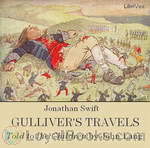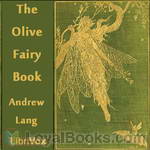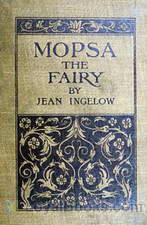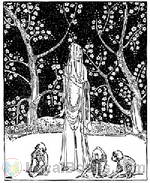|
Books Should Be Free Loyal Books Free Public Domain Audiobooks & eBook Downloads |
|
|
Books Should Be Free Loyal Books Free Public Domain Audiobooks & eBook Downloads |
|
Fantasy Books |
|---|
|
Book type:
Sort by:
View by:
|
By: Ray Cummings (1887-1957) | |
|---|---|
 The World Beyond
The World Beyond
Lee Anthony finds himself and two of his friends kidnapped and taken on a strange voyage. | |
By: Ludovico Ariosto (1474-1533) | |
|---|---|
 Orlando Furioso
Orlando Furioso
Charlemagne's nephew Orlando (AKA Roland) is driven insane by the infidelity of his beloved Angelica. Angelica's relationship with him and others loosely unifies multiple story lines to produce a rich tapestry of romance, fictionalized history, and pure fantasy. This romance-epic is a sequel to the less distinguished and unfinished romance Orlando Innamorato, by Mattteo Maria Boiardo. | |
By: John Lang (1816-1864) | |
|---|---|
 Gulliver's Travels, Told to the Children
Gulliver's Travels, Told to the Children
This is a children's version of Jonathan Swift's novel Gulliver's Travels, from the Told to the Children Series (published in 1910). The children's adventure story covers Gulliver's visits to the lands of Lilliput and Brobdingnag. | |
By: Andrew Lang (1844-1912) | |
|---|---|
 The Olive Fairy Book
The Olive Fairy Book
Andrew Lang’s Olive Fairy Book (1907) was a beautifully produced and illustrated edition of fairy tales that has become a classic. This was one of many other collections of fairy tales, collectively known as Andrew Lang’s Fairy Books. | |
By: Eden Phillpotts (1862-1960) | |
|---|---|
 The Flint Heart
The Flint Heart
The flint heart is a stone of heart shape, forged in prehistoric times, that changes whoever owns it into a wicked person. The story of the flint heart's ultimate defeat involves multiple trips into fairyland by Charles and Unity, children of one of the heart's victims. Along the way the reader meets lots of fun characters such as the king of fairyland, a talking (and wounded) hot water bottle, and the mysterious Zagabog. Occasional references to British words and concepts may require some explanation for American readers, but the story is perfectly understandable without such explications. The droll narration makes the story as much fun for adults as for children. | |
By: Francis Godwin (1562-1633) | |
|---|---|
 The Man in the Moone
The Man in the Moone
A self-serving Spaniard discovers a means of traveling to the moon, describing his sensations in transit in terms remarkably consistent with modern astronauts' experiences. He finds on the moon a utopia, which he describes in detail, but being a fallen creature, he takes the first opportunity of coming home. ( | |
By: Margaret Gatty (1809-1873) | |
|---|---|
 Parables from Nature
Parables from Nature
Parables From Nature is a collection of short stories which were originally published as 4 separate volumes. They are inspired from Nature and written for children. Nevertheless, Gatty uses children's literature because she knows that in doing so, she can reach a wider group of readers and point out problems from the Victorian Age. | |
By: J. M. Barrie (1860-1937) | |
|---|---|
 Peter and Wendy
Peter and Wendy
Peter and Wendy tells the classic story of Peter Pan, a mischievous little boy who can fly, and his adventures on the island of Neverland with Wendy and her brothers, the fairy Tinker Bell, the Lost Boys, the Indian princess Tiger Lily, and the pirate Captain Hook. (Introduction modified from Wikipedia) | |
By: Mary Knight Potter (?-1915) | |
|---|---|
 Peggy's Trial
Peggy's Trial
Ten-year old Peggy Clayton and her two younger brothers, Teddy and Harry, live with their father, Dr. Clayton, and Nurse, a woman who has taken care of them since the death of their mother when Peggy was five. Peggy is a sweet and kind little girl with a big imagination and a great sense of fun. Peggy's Trial follows her adventures with her friends at school, the mischief she and her brothers cause poor old Nurse, and even Peggy’s being chased by a bull. But nothing can prepare Peggy, Teddy and Harry when they fear they may lose their beloved father to a stepmother. | |
By: Jean Ingelow (1820-1897) | |
|---|---|
 Mopsa the Fairy
Mopsa the Fairy
Jean Ingelow (1820 – 1897) was one of the more famous poets of the period, indeed many people suggested that she should succeed Alfred, Lord Tennyson as the first female Poet Laureate when he died in 1892. Mopsa the Fairy, written in 1869 is one of her more enduring stories. It is a delightful fantasy about a young boy who discovers a nest of young fairies and tells of their adventures together. | |
By: Walter De la Mare (1873-1956) | |
|---|---|
 The Three Mulla-mulgars
The Three Mulla-mulgars
Three monkey brothers, Thumb, Thimble, and Nod, are Mulla-mulgars or royal monkeys. As she dies, their mother gives them the enchanted Wonderstone for protection, and tells them to follow their father. They embark on a journey of fantastical adventure to find their father, who left years earlier in search of the kingdom of his brother, the Prince of the Valleys of Tishnar, promising to return for them after he had found the way. | |
By: Various | |
|---|---|
 The Illustrated War News
The Illustrated War News
THE ILLUSTRATED WAR NEWS, N.B.--REMOVE INSETTED LEAFLET, DEC. 30 1914.THE GREAT WAR. In reviewing the events of the last week throughout the world-wide area of war, let us begin with the Dark Continent, where everything went in our favour--very brilliantly so. First of all, then, we may now be said to have completed our conquest of the German Cameroon country by taking possession of the whole of the railway which runs northward from Bonabari, and is now in the hands of our troops. A... | |
 New York Times Current History
New York Times Current History
The New York Times, CURRENT HISTORY, A Monthly Magazine, THE EUROPEAN WAR, VOLUME IIAPRIL, 1915 Germany's War Zone and Neutral Flags The German Decree and Interchange of Notes Answering American Protests to Germany and Britain BERLIN, Feb. 4, (by wireless to Sayville, L.I.)--The German Admiralty today issued the following communication: The waters around Great Britain and Ireland, including the whole English Channel, are declared a war zone on and after Feb. 18, 1915. Every enemy merchant ship found in this war zone will be destroyed, even if it is impossible to avert dangers which threaten the crew and passengers... | |
By: Robert E. Howard (1906-1936) | |
|---|---|
 Hour of the Dragon
Hour of the Dragon
The Hour of the Dragon, also known as Conan the Conqueror, is a fantasy novel by American writer Robert E. Howard featuring his sword and sorcery hero Conan the Cimmerian. It was one of the last Conan stories published before Howard's suicide although not the last to be written. The novel was first published in serial form in the pulp magazine Weird Tales in 1935 through 1936. | |
 Shadows in the Moonlight
Shadows in the Moonlight
For a genuine Conan tale, full of barbarian craftiness, magic, fierce fighting and his berserker strength, this meets every criteria and is one of the best. Conan was raiding with the Free Companions when they were trapped and slaughtered by the merciless Shah Amurath the great Lord of Akif. Conan is one of the very few who escape by hiding in the mud of the marshes like a beast living on raw snake and muskrat. Luck, which seems to have deserted him, smiles again and allows him the chance for revenge and he eagerly seizes it, destroying his enemy with fierce strokes... | |
By: John Rae (1882-1963) | |
|---|---|
 New Adventures of Alice (version 2 Dramatic Reading)
New Adventures of Alice (version 2 Dramatic Reading)
After reading and re-reading the book many time as a boy and wishing that Lewis Carroll would have written another Alice In Wonderland Book, John Rae began imagining what that girl would have gotten up to if he had done so. Telling these stories to his children over the years, where they were enthusiastically received, he finally decided to share them with the world. And here they are! The New Adventures of Alice | |
By: Algernon Blackwood (1869-1951) | |
|---|---|
 Bright Messenger
Bright Messenger
Julian LeVallon, born and raised alone in the Jura Mountains, is referred to psychiatrist Dr. Edward Fillery for care in London. But is LeVallon merely a schizophrenic with a secondary personality, "N.H." (non-human), or is he really an Elemental Being, a "bright messenger" who brings, perhaps, a new age of human evolution? And if so, is the human race ready for a major step forward? | |
By: Various | |
|---|---|
 Short Science Fiction Collection 050
Short Science Fiction Collection 050
Science fiction is a genre encompassing imaginative works that take place in this world or that of the author’s creation where anything is possible. The only rules are those set forth by the author. The speculative nature of the genre inspires thought, and plants seeds that have led to advances in science. The genre can spark an interest in the science and is cited as the impetus for the career choice of many scientists. It is a playing field to explore social perspectives, predictions of the future, and engage in adventures unbound into the richness of the human mind. | |
By: Robert E. Howard (1906-1936) | |
|---|---|
 Gods of the North
Gods of the North
"The Frost-Giant's Daughter" is, arguably the earliest chronological story by Robert E. Howard in terms of Conan's life. The brief tale is set somewhere in frozen Nordheim, geographically situated north of Conan's homeland, Cimmeria. Conan is depicted by Howard as a youthful Cimmerian mercenary traveling among the golden-haired Aesir in a war party. Shortly before the story begins, a hand-to-hand battle has occurred on an icy plain. Eighty men ("four score") have perished in bloody combat, and Conan alone survives the battlefield where Wulfhere's Aesir "reavers" fought the Vanir "wolves" of Bragi, a Vanir chieftain... | |
By: Various | |
|---|---|
 Short Science Fiction Collection 052
Short Science Fiction Collection 052
Science fiction is a genre encompassing imaginative works that take place in this world or that of the author’s creation where anything is possible. The only rules are those set forth by the author. The speculative nature of the genre inspires thought and plants seeds that have led to advances in science. The genre can spark an interest in the science and is cited as the impetus for the career choice of many scientists. It is a playing field to explore social perspectives, predictions of the future, and engage in adventures unbound into the richness of the human mind. | |
By: James Elroy Flecker (1884-1915) | |
|---|---|
 King of Alsander (Dramatic Reading)
King of Alsander (Dramatic Reading)
First published in 1914, the King of Alsander is the only novel by James Elroy Flecker, best known as a poet, but also a noted scholar, linguist and diplomat. Flecker's love of learning, language and travel, and his keen satirical insight into politics are all in evidence in this phantasmagoric tale. As the author himself describes it: Here is a tale all romance - a tale such as only a Poet can write for you, O appreciative and generous Public - a tale of madmen, kings, scholars, grocers, consuls,... | |
By: Various | |
|---|---|
 Fantasy, Faeries and Ghosts
Fantasy, Faeries and Ghosts
In this collection three of the original titans in the field of fantasy literature (Edgar Allan Poe, George MacDonald, Joseph Sheridan Le Fanu) take you on a magical guided tour of fairyland and adjoining countries and introduce you to whimsical, strange and even scary encounters and adventures with inhabitants such as good and bad fairies, ghosts and even the Devil. The stories included are “Cross Purposes” “The Carasoyn” “Bon-Bon” “The Child That Went With The Fairies” “Madam Crowl’s Ghost” and as an added bonus the beautiful (and cautionary) fairy poem “Queen Mab” by Thomas Hood. | |
By: E. E. Smith (1890-1965) | |
|---|---|
 Lord Tedric
Lord Tedric
Time is the strangest of all mysteries. Relatively unimportant events, almost unnoticed as they occur, may, in hundreds of years, result in Ultimate Catastrophe. On Time Track Number One, that was the immutable result. But on Time Track Number Two there was one little event that could be used to avert it—the presence of a naked woman in public. So, Skandos One removed the clothing from the Lady Rhoann and after one look, Lord Tedric did the rest! | |
 Lord Tedric (version 2)
Lord Tedric (version 2)
The best of science fantasy meets the best of science fiction as Tedric battles his way through two universes of adventure: In one universe...Tedric the Ironmaster wields the mightiest sword his world has ever seen - and swears to break the power of the evil god Sarpedion, or die in the attempt. This is the second in a series and takes place when Tedric, now a Lord, begins learning how to plan and observe instead of just rushing in to kill. In another universe...only Tedric's strength and daring stand between the dwindling power of the Terran Empire and total alien conquest... | |
By: H. P. Lovecraft (1890-1937) | |
|---|---|
 The Dunwich Horror
The Dunwich Horror
In a rundown farmhouse near isolated, rural Dunwich, a bizarre family conjures and nurtures an evil entity from another realm, with the purpose of destroying the world and delivering it to ancient gods to rule, and only an aged university librarian can stop them. The Dunwich Horror was first published in 1929 in Weird Tales. | |
By: Robert E. Howard (1906-1936) | |
|---|---|
 Shadows in Zamboula
Shadows in Zamboula
Despite a warning received in the Suq by an elderly desert nomad, Conan stays the night in a cheap tavern in Zamboula, run by Aram Baksh. As night falls, a black Darfarian cannibal enters to drag him away to be eaten. All of the Darfar slaves in the city are cannibals who roam the streets at night. As they only prey on travellers, the people of the city tolerate this and stay locked securely in their homes, while nomads and beggars make sure to spend the night at a comfortable distance from its walls... | |
By: Various | |
|---|---|
 Short Science Fiction Collection 051
Short Science Fiction Collection 051
Science fiction is a genre encompassing imaginative works that take place in this world or that of the author’s creation where anything is possible. The only rules are those set forth by the author. The speculative nature of the genre inspires thought and plants seeds that have led to advances in science. The genre can spark an interest in the science and is cited as the impetus for the career choice of many scientists. It is a playing field to explore social perspectives, predictions of the future, and engage in adventures unbound into the richness of the human mind. | |
By: Robert E. Howard (1906-1936) | |
|---|---|
 People of the Black Circle (version 2)
People of the Black Circle (version 2)
The People of the Black Circle" is one of the original novellas about Conan the Cimmerian, written by American author Robert E. Howard and first published in Weird Tales magazine in three parts over the September, October and November 1934 issues. Howard earned $250 for the publication of this story. It is set in the pseudo-historical Hyborian Age and concerns Conan kidnapping a regal princess of Vendhya (pre-historical India) and foiling a nefarious plot of world domination by the Black Seers of Yimsha... | |
By: Various | |
|---|---|
 Short Science Fiction Collection 053
Short Science Fiction Collection 053
Science fiction is a genre encompassing imaginative works that take place in this world or that of the author’s creation where anything is possible. The only rules are those set forth by the author. The speculative nature of the genre inspires thought and plants seeds that have led to advances in science. The genre can spark an interest in the sciences and is cited as the impetus for the career choice of many scientists. It is a playing field to explore social perspectives, predictions of the future, and engage in adventures unbound into the richness of the human mind. | |
By: Various | |
|---|---|
 Fantasy, Faeries and Ghosts, Volume 2
Fantasy, Faeries and Ghosts, Volume 2
Join the original masters of fantasy E.T.A Hoffmann, George MacDonald, Violet Hunt, J. Sheridan Le Fanu and Bram Stoker as they whisk you into the world of faeries and it’s mystical regions far beyond imagination. In this amazing collection you will find gnomes, fairies, changelings, phantoms and other bizarre wonderful creatures of the ethereal realms. Here are six tales sure to please all those that enjoy fantasy literature at it’s finest. - Summary by kadath | |
 Short Science Fiction Collection 055
Short Science Fiction Collection 055
Science fiction is a genre encompassing imaginative works that take place in this world or that of the author’s creation where anything is possible. The only rules are those set forth by the author. The speculative nature of the genre inspires thought and plants seeds that have led to advances in science. The genre can spark an interest in the sciences and is cited as the impetus for the career choice of many scientists. It is a playing field to explore social perspectives, predictions of the future, and engage in adventures unbound into the richness of the human mind. | |
By: Marie Corelli (1855-1924) | |
|---|---|
 Young Diana
Young Diana
Poor Diana May. Her fiancé has jilted her, her parents think she is an encumbrance and no one recognises her intelligence. She seems destined to remain unloved, unappreciated and unpaid - until she decides to take control of her life. It all begins with an advertisement for an assistant to an eccentric scientist with a hidden laboratory in Switzerland... - Summary by Newgatenovelist | |